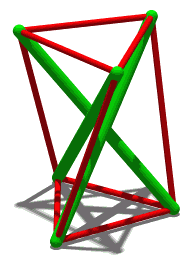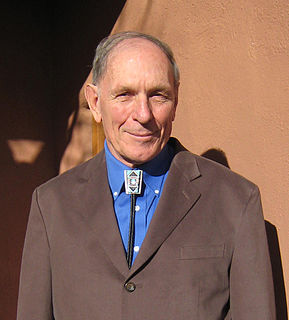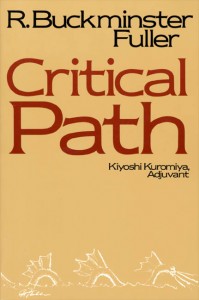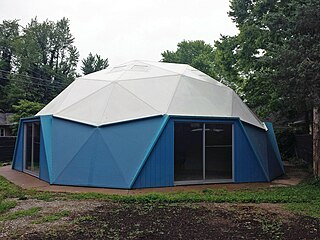Related Research Articles

Richard Buckminster Fuller was an American architect, systems theorist, author, designer, inventor, and futurist. He styled his name as R. Buckminster Fuller in his writings, publishing more than 30 books and coining or popularizing such terms as "Spaceship Earth", "Dymaxion", "ephemeralization", "synergetics", and "tensegrity".

Terraforming or terraformation is the hypothetical process of deliberately modifying of the atmosphere, temperature, surface topography or ecology of a planet, moon, or other body to be similar to the environment of Earth to make it habitable by Earth-like life.

A geodesic dome is a hemispherical thin-shell structure (lattice-shell) based on a geodesic polyhedron. The triangular elements of the dome are structurally rigid and distribute the structural stress throughout the structure, making geodesic domes able to withstand very heavy loads for their size.

Tensegrity, tensional integrity or floating compression is a structural principle based on a system of isolated components under compression inside a network of continuous tension, and arranged in such a way that the compressed members do not touch each other while the prestressed tensioned members delineate the system spatially.
Environmental design is the process of addressing surrounding environmental parameters when devising plans, programs, policies, buildings, or products. It seeks to create spaces that will enhance the natural, social, cultural and physical environment of particular areas. Classical prudent design may have always considered environmental factors; however, the environmental movement beginning in the 1940s has made the concept more explicit.
World Game, sometimes called the World Peace Game, is an educational simulation developed by Buckminster Fuller in 1961 to help create solutions to overpopulation and the uneven distribution of global resources. This alternative to war games uses Fuller's Dymaxion map and requires a group of players to cooperatively solve a set of metaphorical scenarios, thus challenging the dominant nation-state perspective with a more holistic "total world" view. The idea was to "make the world work for 100% of humanity in the shortest possible time through spontaneous cooperation without ecological damage or disadvantage to anyone," thus increasing the quality of life for all people.

Spaceship Earth is a worldview encouraging everyone on Earth to act as a harmonious crew working toward the greater good.
Ecological engineering uses ecology and engineering to predict, design, construct or restore, and manage ecosystems that integrate "human society with its natural environment for the benefit of both".
In futures studies and the history of technology, accelerating change is a perceived increase in the rate of technological change throughout history, which may suggest faster and more profound change in the future and may or may not be accompanied by equally profound social and cultural change.
A concept of design science was introduced in 1957 by R. Buckminster Fuller who defined it as a systematic form of designing. He expanded on this concept in his World Design Science Decade proposal to the International Union of Architects in 1961. The term was later used by S. A. Gregory in the 1965 'The Design Method' Conference where he drew the distinction between scientific method and design method. Gregory was clear in his view that design was not a science and that design science referred to the scientific study of design. Herbert Simon in his 1968 Karl Taylor Compton lectures used and popularized these terms in his argument for the scientific study of the artificial. Over the intervening period the two uses of the term have co-mingled to the point where design science may have both meanings: a science of design and design as a science.

John Polk Allen is a systems ecologist, engineer, metallurgist, adventurer, and writer. Allen is a proponent of the science of biospherics and a pioneer in sustainable co-evolutionary development. He is the founder of Synergia Ranch, and is best known as the inventor and director of research of Biosphere 2, the world's largest vivarium and research facility to study global ecology. Biosphere 2 set multiple records in closed ecological systems work, including degree of sealing tightness, 100% waste and water recycle, and duration of human residence within a closed system. He is also involved with forestry and reforestation in Puerto Rico where he owns a 1000 acre Mahogany tree farm at Patillas.

Clifford Allan Redin Savory is a Zimbabwean ecologist, livestock farmer, and president and co-founder of the Savory Institute. He originated Holistic management (agriculture), a systems thinking approach to managing resources.

Critical Path is a book written by US author and inventor R. Buckminster Fuller with the assistance of Kiyoshi Kuromiya. First published in 1981, it is alongside Operating Manual for Spaceship Earth one of Fuller's best-known works. Vast in its scope, it describes Fuller's own vision of the development of human civilization, economic history, and his highly original economic ideology based, amongst other things, on his detailed description of why scarcity of resources need no longer be a decisive factor in global politics.
The Regeneration refers to people of all ages who share a common interest in renewable resources, recycling and other means of sustaining the earth's natural environment.
Ecological design or ecodesign is an approach to designing products with special consideration for the environmental impacts of the product during its whole lifecycle. It was defined by Sim Van der Ryn and Stuart Cowan as "any form of design that minimizes environmentally destructive impacts by integrating itself with living processes." Ecological design is an integrative ecologically responsible design discipline. Ecological design can also be posited as the process within design and development of integration environmental consideration into product design and development with the aim of reducing environmental impacts of products through their life cycle.
Synergetics is the empirical study of systems in transformation, with an emphasis on total system behavior unpredicted by the behavior of any isolated components, including humanity's role as both participant and observer.

Planetary boundaries is a concept involving Earth system processes that contain environmental boundaries. It was proposed in 2009 by a group of Earth system and environmental scientists, led by Johan Rockström from the Stockholm Resilience Centre and Will Steffen from the Australian National University. The group wanted to define a "safe operating space for humanity" for the international community, including governments at all levels, international organizations, civil society, the scientific community and the private sector, as a precondition for sustainable development. The framework is based on scientific evidence that human actions since the Industrial Revolution have become the main driver of global environmental change.

Robert Edward Williams is an American designer, mathematician, and architect. He is noted for books on the geometry of natural structure, the discovery of a new space-filling polyhedron, the development of theoretical principles of Catenatic Geometry, and the invention of the Ars-Vivant Wild-life Protector System for repopulating the Western Mojave Desert in California, USA with desert tortoises.

The ASM International Headquarters and Geodesic Dome, at the Materials Park campus in Russell Township, Geauga County, Ohio, United States, are the headquarters of ASM International, a professional organization for materials scientists and engineers. These modernist structures were built in 1958 and dedicated in September 1959.

The R. Buckminster Fuller and Anne Hewlett Dome Home, located at 407 S. Forest Ave. in Carbondale, Illinois, is a geodesic dome house which was the residence of Buckminster Fuller from 1960 to 1971. The house, inhabited by Fuller while he taught at Southern Illinois University, was the only geodesic dome Fuller lived in as well as the only property he ever owned. Fuller, a prolific architect and engineer, popularized the geodesic dome as a building design, and his house was one of the first geodesic dome residences to be constructed. The home was built and designed by Al Miller of the Pease Woodworking Company. While living in the home, Fuller was awarded nine patents, published eleven books, and designed the Montreal Biosphère, one of his most famous works.
References
- ↑ Fuller, R. B. (May 1, 1983). "Humanity's Critical Path: From Weaponry to Livingry" (PDF). Proteus. 1 (1). Retrieved 2016-09-15.
- ↑ Fuller, R. B.; McHale, J. (1964). "World Design Science Decade documents". Buckminster Fuller Institute. Southern Illinois University. Retrieved 2016-09-14.
- ↑ Fuller, R. B.; Kuromiya, K. (1992). Cosmography: A posthumous scenario for the future of humanity. New York: Macmillan. ISBN 0025418505.
- ↑ Fuller, R. B. (1983). Grunch of Giants. New York: St. Martin's Press. ISBN 0974060518.
- ↑ Fuller, R. B.; Applewhite, E. J. (1975). Synergetics: Explorations in the Geometry of Thinking. New York: Macmillan. pp. 172.00–173.00. ISBN 0020653204.
- ↑ Fuller, R. B. (1968). "World Game - How It Came About from The World Game: Integrative Resource Utilization Planning Tool" (PDF). Buckminster Fuller Institute. Southern Illinois University. Retrieved 2016-09-13.